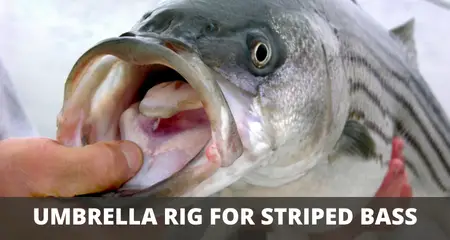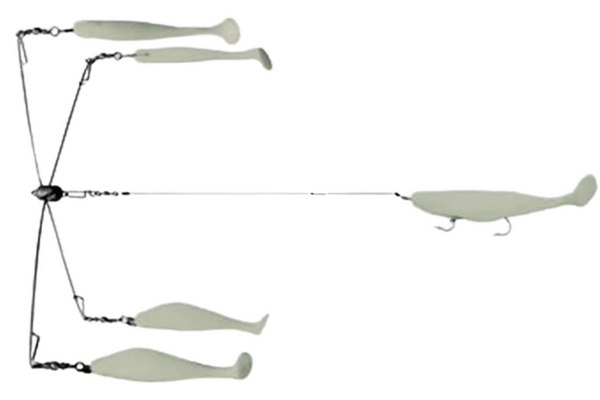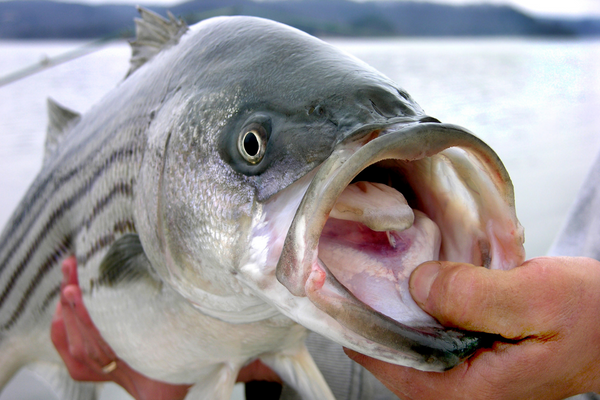Fishing Umbrella Rigs For Striped Bass (3 Expert Tips)
UPDATED 03 NOVEMBER 2023
by Robert Ceran
Nothing in the water stimulates the predatory reaction in fish more than the sight of a school of baitfish swimming by.
And there is nothing that imitates the appearance of a school of baitfish more effectively than an umbrella rig, period!
When properly rigged, umbrella rigs have the potential to be the most productive lure of all that are available to anglers in the pursuit of monster Stripers.

Why are umbrella rigs so effective for stripers?
Umbrella rigs are so successful because they stimulate the natural predatory reaction in fish, which causes them to become more aggressive.
When one of these rigs comes close to them, they are practically unable to control their excitement.
Consider the fact that stripers travel to this region with only two goals in mind: the first of which is to bulk up for the following winter.
The umbrella gives the appearance of and operates similarly to a small group of baitfish (6-inch shad) that has become separated from the larger group, which leaves them exposed.
A larger fish, maybe a shad measuring 9 or 12 inches, is following them closely and is only a few seconds away from a meal.
When a striper spots a trailing fish, it becomes determined to catch it. The striper is the highest point in this food chain and will not skip an opportunity like this.
This is why the umbrella rig will catch more striped bass than anything else!
How to make an umbrella rig
While you can buy umbrella rigs already rigged, it is not difficult to make them yourself, and you can make your own for far less than the cost of purchasing them pre-rigged.

To build an umbrella rig, you will need the following components:
- Blank four-arm umbrella made out of stainless steel wire
- Four straight wire 2/0 or 3/0 snap swivels (used to hold the teaser shads in place securely)
- Four 6-inch shad bodies of your preferred color
- One 9- or 12-inch shad body with at least a 12-0 hook
- 60- to 80-pound monofilament line to attach the large shad body
The last component you’ll need consists of a split ring and an inline sinker. A few years ago, I discovered this is a highly efficient method for adding some weight straight to the center post of the umbrella rig.
Your go-to local tackle store will have all the components in stock, and while you’re there, you should probably pick up enough components to construct at least a couple of variations of this rig.
Chartreuse, pearl, and pure white or a gold hue are my top three recommendations for the body color of the shad.
Putting a straight snap swivel into the head of a shad body that is six inches long is the way that is both the simplest and the safest for connecting a teaser to a shad that is six inches long.
Put the pin just in the middle of the shad’s head and in until you reach the bend in the wire.
Close the swivel after rotating it so that the tip emerges from the top of the shad’s body, then proceed to close the swivel.
Attaching shad bodies to swivels can be done in several different ways, but it has come to my attention that this approach is the one that is the most reliable and risk-free.
The eye of the swivel needs to be threaded onto one of the arms of the umbrella rig, which needs to be repeated for the other arms.
Putting this rig together begins with rigging the center post, which is the most critical stage in the process.
Rigging the center post of the umbrella rig
On the center post, tie either a huge bucktail, parachute, or large nine to twelve-inch soft plastic shad body to a mono leader that is two to three feet long and has a breaking strength of sixty to eighty pounds.

The objective here is to show a very large profile to the enormous fish you will be fishing for.
When utilizing a bucktail or parachute in conjunction with a shad body, place a big size 8/0 to 10/0 hook into the shad such that the eye of the hook protrudes slightly beyond the shad.
Bring the eye of this hook across to where the hook is located on the parachute.
The barb may need to be somewhat compressed to get the shad hook over the other one.
You can tie the other end of the leader directly to the center post or use a high-quality snaplock style swivel instead.
Swivels with ball bearings and a test rating of at least 80 pounds are the best options for this purpose.
Introducing the mini umbrella rig
Umbrella rigs are typically constructed with four arms, and a single arm’s length ranges from eight to nine inches.
But now, this setup has a new variation – a version with shorter arms! It has a total diameter of only 12 inches.
You may fish this novel umbrella rig at any depth in the water column; however, its strengths lie in the shallower and more intermediate levels, as well as in conditions where there is a strong current or when there is a lot of wind.
If you use these with full-sized umbrellas, you will have one of the deadliest tools possible to attract trophy-sized stripers.
Compared to regular-size umbrellas, this setup creates less resistance in the water and is friendlier on your fishing gear.
Using a standard umbrella might be challenging when the water is choppy, or the current is strong.
These smaller models are much easier to operate while being equally successful as their larger counterparts in capturing fish.
Small umbrella rigs are best fished with a somewhat light inline sinker (2-4 ounces), held close to the water’s surface and positioned toward the rear of your spread.
This rig may be fished relatively easily in the center of the water column when using an inline sinker of six ounces, which is almost the ideal weight for this purpose.
How to avoid umbrella rig tangles
I like to throw this rig from the side of the boat while I cast my biggest lures right off the stern. Doing so will protect the baits from any possible tangles that may develop!
Final remarks
Utilize the umbrella to your advantage, and enjoy catching trophy-sized stripers!
Even when other lures are not successful in catching stripers, these rigs will continue to provide you with nice catches of fish.
